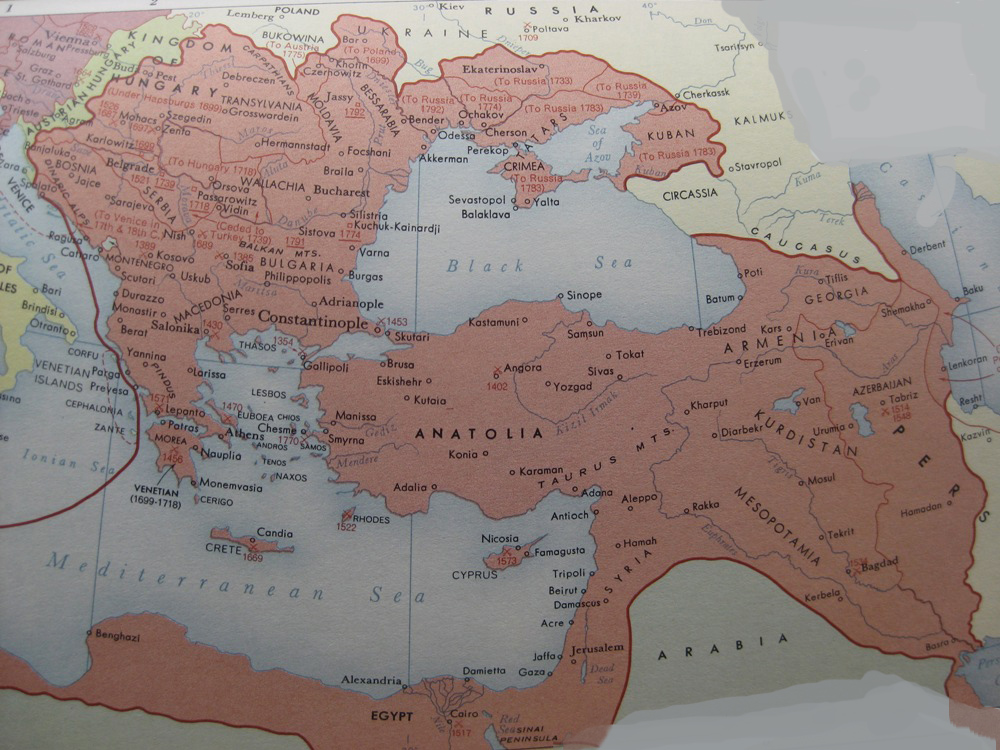Do you know what the geographical boundaries of the Ottoman Empire were? I didn’t; I admit I had to look it up. Here’s a map to help us along. Turkey is what’s left today of the Ottoman Empire, which picked the wrong side in WW I and was then dismembered by the West.

The Ottoman Empire in about 1900; in North Africa it extended west to present-day Algeria.
The West tends to think of the Ottomans as barbarian conquerors. But the reality is quite the opposite. The creation of the Ottoman Empire is not that of a smooth war machine rolling over new territory, although from a distance that is how it appears. One of the keys to the success of the Ottoman Empire was its inclusion of other cultures in a variety of ways. For example, Sultan Bayezid II welcomed the Jews, expelled from Spain during Queen Isabella’s bloody and belligerently intolerant Inquisition, offering them refuge in Istanbul.
Almost always, the Ottomans supported religious and cultural diversity—note the almost. The Janissaries were one of their exceptions. This corps of brutal, well-trained military troops was made up of young Christian youths who were captured as slaves and—there’s no other word for it—brainwashed to became the Ottoman’s not-so-secret key to their military success. The Janissaries cut a swathe sword by sword through the expanding Ottoman territory.
The Ottomans controlled the Spice Route for a few centuries and not only transported and sold exotic spices, but incorporated them into their cuisine. The ecological diversity of the Empire and control of the Spice Route weren’t the only reasons for the development of Ottoman cuisine. During the seventeenth century, the Ottoman Empire had some 1,300 kitchen staff living in Topkapi Palace, sometimes feeding up to ten thousand people a day. There were numerous specialists in specific menu items from mezes to dessert pastries and everything in between. Pleasing the royal palate has to be added to freshness and spices as a factor in creating their diverse cuisine.
Without getting lost in the contours of the development of the Ottoman Empire, I preferred to focus in on Süleyman I, who ruled from 1520 to 1566 CE. He was known to the West as the Magnificent, and to his people as Kanunî Sultan Süleyman, the Law-giver. His story should be an opera. It has all the ingredients of a great, raging tragic legend. He came to power quite legitimately and controlled the empire at its largest territorially. He was considerably more than the frightening conqueror as Europe viewed him, although his conquest of Hungary certainly supported that view. He initiated many cultural, architectural, and infrastructure projects. Istanbul was the most civilized and resplendent city in the world during his reign. And he was the Law-giver, codifying a just and thorough legal system.
Then the story changed for he fell in love with one of his concubines, Roxelana, who became known as Hürrem Sultan; and he actually married her. She was a street-smart, power-hungry, exotically beautiful woman. Originally from a part of the Kingdom of Poland that is in the Ukraine today, she was captured as a slave, sold and resold, ending up in Istanbul, where she was purchased for the sultan’s harem. She quickly made her way from there to the sultan’s heart. She arranged the death of his closest friend since childhood, Ibrahim Pasha, who had risen to have great influence with Süleyman, thus becoming a perceived threat to Roxelana. She also had his sons by other concubines murdered so as to ensure the ascendance of her son. Roxelana did more than contrive deaths; she was a benefactor to schools and a hospital for women, and was a major influence on her husband to maintain peaceful relations with the Kingdom of Poland and to stop the capturing of slaves in the area from which she had come.
Her son, Selim I, was known as The Sot. Befitting that name, he seems to have been a spoiled profligate and inherited none of his parents’ skills in politics or warfare, and was the first in a series of incompetent sultans that weakened the empire and contributed to its ultimate downfall much later. Intrigue, murder, war, peace, and the slave girl who captured the sultan’s heart—it all happened during Süleyman and Roxelana’s reign.
Note: Much of this information is from Voice of a Voyage and my research for that and when we were in the former Ottoman Empire territory.
